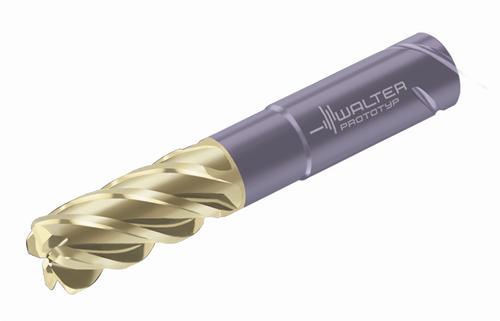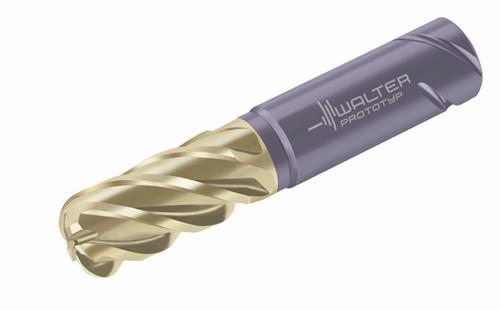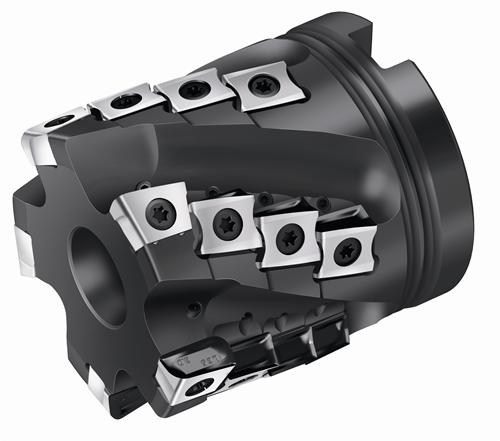Safe And Fast Titanium alloy Machining Using Carbide Tools
The situation in the aviation industry is slightly different from other industries. Weight plays an important role, and every gram cannot be ignored. It is the weight of the product that determines its profitability, not the price of the parts. Undoubtedly, titanium alloys have maintained a large growth in the industry and are generally welcomed. In particular, high-strength members use the most titanium alloys. Typical examples are attachments around doors and door frames, landing gear supports, undercarriage brackets or landing flap tracks. Titanium alloys are also resistant to corrosion and high temperatures.
But, especially civil aircraft manufacturers, they find themselves facing increasing manufacturing pressures that are similar to the automotive industry. So far, Boeing, Airbus and Bombardier have dominated the market, and Bombardier has a relatively small market share. At the same time, China and Russia are new competitors and are preparing to enter the market. As a result, manufacturers are under increasing pressure and they must be as cost-effective as possible. The Xpress Aerospace series successfully developed by Walter has made important contributions in this regard.

Dirk Masur is an aviation industry parts manager and expert in Walter titanium processing
Latest research results of cemented carbide tool systems
Challenge: Titanium alloys are more difficult to machine than aluminum alloys and are the materials most used to date. This material is highly chemically reactive, causing chips to be melted on the cutting edge during processing. Because of the poor thermal conductivity of the material, the temperature at the cutting edge rises sharply. This causes the condition of the swarf to be extremely bad and the wearability to be particularly large. The minimum modulus of elasticity causes the workpiece to bend. Plus the material solidifies in the cutting edge area, so even at low cutting speeds, the tool life is reduced.
Tool costs are highly dependent on the need for parts, materials and processes. Reducing the wall thickness can cause the parts to become extremely unstable, so the weight of the machining is to consider the stability and clamping stability of the machine. The use of an appropriate coolant strategy also has a serious impact on tool life. Walter continues to develop tooling systems designed to reduce processing time. The cemented carbide matrix, the new coating technology, and the macro-groove and micro-groove shape of the cutting tool play an important role at this time. However, by working with CAD/CAM experts, the processing strategy can be further optimized.

All of this makes high-performance cutting (HPC) and high-power cutting (HDC) for today's titanium alloy finishing and roughing possible. The powerful milling and innovative new coating of the Walter Prototyp Ti38 Z6-10 achieves a cutting speed of 140 m/min. A multi-tooth solution of up to 10 teeth increases the feed rate by 50% at small contact widths. These solid carbide tooling solutions increase metal removal by 50% compared to conventional solutions.

Carbide tool coating determines life
An example of a newly developed substrate and coating technology is the PVD based coating (physical vapor deposition) of the Walter Prototyp Ti series of solid carbide. Compared with the traditional ANC coating (chromium nitride), this coating can greatly extend the tool life - more than 100%. For example, when using Prototyp HPC Ti40 for semi-finishing and finishing, a window frame made of 3.7164 titanium alloy with a tensile strength of 1250 N/mm2, Tool life is extended by 154%, from 175 minutes to 444 minutes. Finishing with the Prototyp HDC Ti38 L, the profile extends tool life by 116%. The speed is increased by 25% and the processing volume is increased by 23%.

However, in this case, a corresponding cooling strategy must be implemented to maintain the cutting edge processing temperature at 600 degrees Celsius. In general, the concentration of cutting fluid and cooling medium has a major impact on tool life. The most important thing is to introduce the cooling medium directly into the work area as much as possible. This is achieved by the special coolant channel of the tool.
70 bar high pressure cooling is the latest technology in new machine tools. Non-standard tool solutions for low temperature processing, using liquid carbon dioxide or liquid nitrogen processing, whichever is lower.
From tool suppliers to technology partners
Walter sees itself as a digital process partner and has developed tools that are closely related to the “parts machining solution”. This requires a complete team of experts. In order to fully evaluate the process, the most critical prerequisite is skilled CAD/CAM skills. To meet customer needs, Walter provides tools, solutions and services for the entire process.
As a result, Walter worked with the University of Sheffield Advanced Manufacturing Research Center many years ago to develop a "parts processing solution." During the project, a non-standard processing strategy was developed for all the dimple shapes of the structural members using the CAM program commonly used in the aerospace industry. This "toolbox" allows the corresponding machining process to be derived quickly and efficiently from the 3D model of the customer's part.
Best quality, shortest time
"Good things are always accompanied by those who wait patiently" are no longer applicable today. Even with high-performance tools of non-standard size tailored to customer needs, there is tremendous time pressure. As a result, Walter has provided a long-established Walter Xpress service for industries such as the aerospace industry since the beginning of the year. The lead time for the Xpress tooling solution is 2 to 3 weeks. Speed begins with the ordering process itself. The my.Walter software solution allows customers to design tools online, either in collaboration with trained field service personnel. With "Walter Online Xpress", customers receive a binding quote via email within 1 hour, including 2D drawings and 3D models. The order itself is often the bottleneck of the company, and after using Walter tool management, the order has also been greatly accelerated.
But, especially civil aircraft manufacturers, they find themselves facing increasing manufacturing pressures that are similar to the automotive industry. So far, Boeing, Airbus and Bombardier have dominated the market, and Bombardier has a relatively small market share. At the same time, China and Russia are new competitors and are preparing to enter the market. As a result, manufacturers are under increasing pressure and they must be as cost-effective as possible. The Xpress Aerospace series successfully developed by Walter has made important contributions in this regard.

Dirk Masur is an aviation industry parts manager and expert in Walter titanium processing
Latest research results of cemented carbide tool systems
Challenge: Titanium alloys are more difficult to machine than aluminum alloys and are the materials most used to date. This material is highly chemically reactive, causing chips to be melted on the cutting edge during processing. Because of the poor thermal conductivity of the material, the temperature at the cutting edge rises sharply. This causes the condition of the swarf to be extremely bad and the wearability to be particularly large. The minimum modulus of elasticity causes the workpiece to bend. Plus the material solidifies in the cutting edge area, so even at low cutting speeds, the tool life is reduced.
Tool costs are highly dependent on the need for parts, materials and processes. Reducing the wall thickness can cause the parts to become extremely unstable, so the weight of the machining is to consider the stability and clamping stability of the machine. The use of an appropriate coolant strategy also has a serious impact on tool life. Walter continues to develop tooling systems designed to reduce processing time. The cemented carbide matrix, the new coating technology, and the macro-groove and micro-groove shape of the cutting tool play an important role at this time. However, by working with CAD/CAM experts, the processing strategy can be further optimized.

All of this makes high-performance cutting (HPC) and high-power cutting (HDC) for today's titanium alloy finishing and roughing possible. The powerful milling and innovative new coating of the Walter Prototyp Ti38 Z6-10 achieves a cutting speed of 140 m/min. A multi-tooth solution of up to 10 teeth increases the feed rate by 50% at small contact widths. These solid carbide tooling solutions increase metal removal by 50% compared to conventional solutions.

Carbide tool coating determines life
An example of a newly developed substrate and coating technology is the PVD based coating (physical vapor deposition) of the Walter Prototyp Ti series of solid carbide. Compared with the traditional ANC coating (chromium nitride), this coating can greatly extend the tool life - more than 100%. For example, when using Prototyp HPC Ti40 for semi-finishing and finishing, a window frame made of 3.7164 titanium alloy with a tensile strength of 1250 N/mm2, Tool life is extended by 154%, from 175 minutes to 444 minutes. Finishing with the Prototyp HDC Ti38 L, the profile extends tool life by 116%. The speed is increased by 25% and the processing volume is increased by 23%.

However, in this case, a corresponding cooling strategy must be implemented to maintain the cutting edge processing temperature at 600 degrees Celsius. In general, the concentration of cutting fluid and cooling medium has a major impact on tool life. The most important thing is to introduce the cooling medium directly into the work area as much as possible. This is achieved by the special coolant channel of the tool.
70 bar high pressure cooling is the latest technology in new machine tools. Non-standard tool solutions for low temperature processing, using liquid carbon dioxide or liquid nitrogen processing, whichever is lower.
From tool suppliers to technology partners
Walter sees itself as a digital process partner and has developed tools that are closely related to the “parts machining solution”. This requires a complete team of experts. In order to fully evaluate the process, the most critical prerequisite is skilled CAD/CAM skills. To meet customer needs, Walter provides tools, solutions and services for the entire process.
As a result, Walter worked with the University of Sheffield Advanced Manufacturing Research Center many years ago to develop a "parts processing solution." During the project, a non-standard processing strategy was developed for all the dimple shapes of the structural members using the CAM program commonly used in the aerospace industry. This "toolbox" allows the corresponding machining process to be derived quickly and efficiently from the 3D model of the customer's part.
Best quality, shortest time
"Good things are always accompanied by those who wait patiently" are no longer applicable today. Even with high-performance tools of non-standard size tailored to customer needs, there is tremendous time pressure. As a result, Walter has provided a long-established Walter Xpress service for industries such as the aerospace industry since the beginning of the year. The lead time for the Xpress tooling solution is 2 to 3 weeks. Speed begins with the ordering process itself. The my.Walter software solution allows customers to design tools online, either in collaboration with trained field service personnel. With "Walter Online Xpress", customers receive a binding quote via email within 1 hour, including 2D drawings and 3D models. The order itself is often the bottleneck of the company, and after using Walter tool management, the order has also been greatly accelerated.





